Every night could be an aurora night. Don't Miss Out
Northwest Iceland is a stunning region filled with diverse landscapes. Staggering peninsulas, majestic fjords, wild rivers, and deep canyons, this territory is a fantastic spot for wilderness adventurers. The natural highlights of the Northwest are now among Iceland’s most renowned attractions. The Lonely Planet chose Borgafjörður as one of the ‘Top 10 Regions To Visit in 2016.’
Join our knowledgeable and experienced guides on a day tour to explore Iceland’s north western areas.
You want to spend more than one day to explore the beauty of Iceland’s north west? We have compiled some truly unique tours over multiple days.
Located in the westernmost part of Iceland, the Westfjords showcase the raw, wild beauty of the island. Far from the city, these Iceland natural north west attractions are the country’s hidden gems.
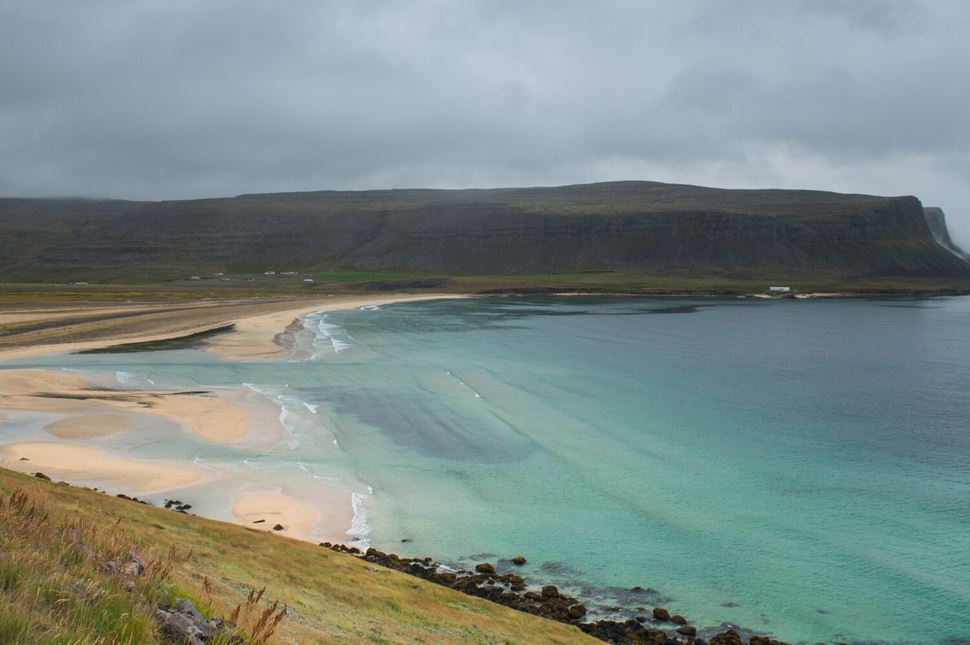
The Westfjords is a wide peninsula that stretches north west of Iceland. The region boasts beautiful mountains, fjords, and wildlife. Hornstrandir Nature Reserve is a protected area of the Westfjords. Visitors love the serene atmosphere, stunning scenery, and superb hiking trails.
One of Iceland’s many famous waterfalls is located in the Westfjords. Dynjandi, meaning ‘Thunderous,’ is a series of seven waterfalls, with a total height of 100 meters (330 feet). This powerful feat of nature is an impressive sight to witness.
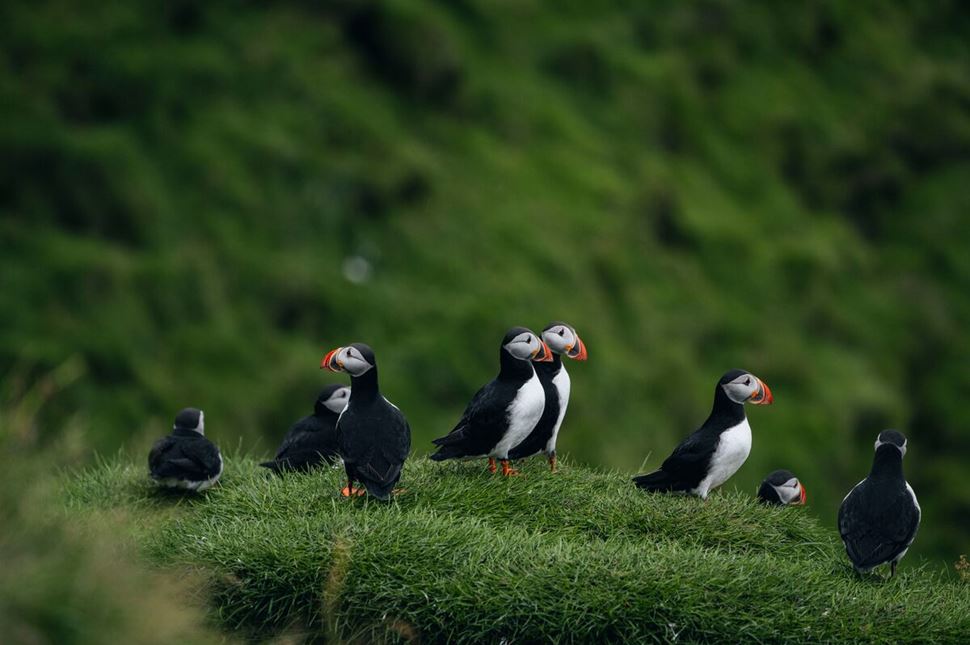
Over on the westernmost part of the region is Látrabjarg, Iceland’s popular birdwatching cliffs. A seabird haven, millions of various bird species nest here including the famous Atlantic Puffins.
Near the cliff is Rauðasandur Beach, known for its unique pale red, pinkish sand. The beach is home to hundreds of seals as well as seabirds.
The capital of this remote region is Ísafjörður, with only 3,000 year-round residents. Smaller fishing villages are scattered around the fjords, as fish are plentiful in the area.
Hornstrandir is a picturesque nature reserve located in the Westfjords of Northwest Iceland. Established in 1975, it covers 580 square kilometers (220 square miles) of raw wilderness. Knee-high vegetation and flowering plants blanket the area, with about 260 different in total.
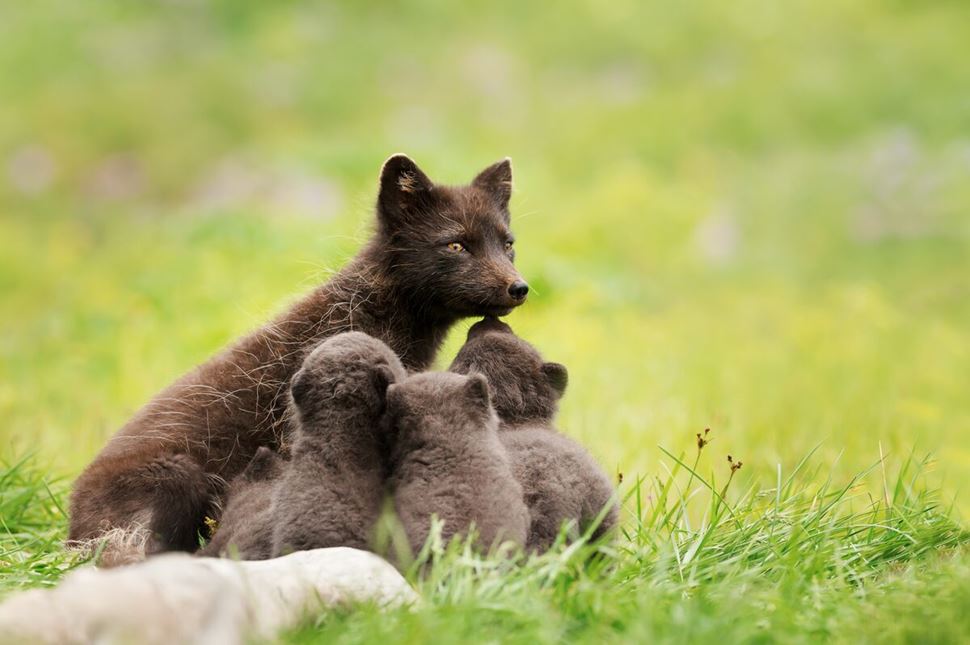
One of the reasons for the lush plant life is the absence of permanent human residents, who left in the 1950s. The untamed habitat of Hornstrandir provides the perfect home for wildlife, like the rare Arctic Fox. Two of the largest bird cliffs in Europe can also be found in the area.
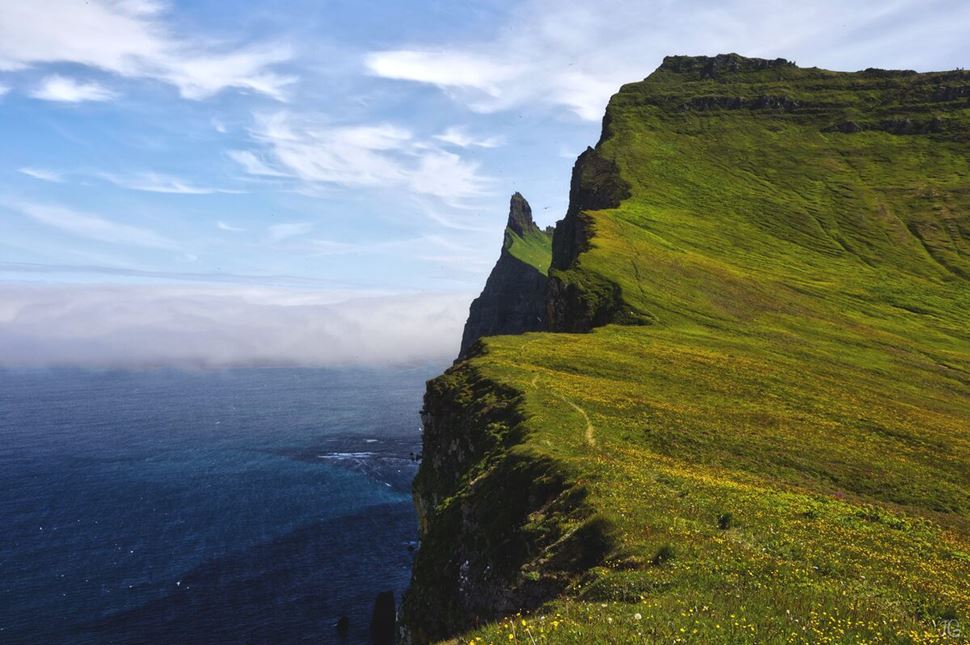
Hornbjarg Cliff is the reserve’s most famous natural feature. Hiking to the top is a bucket-list activity for visitors, who will be greeted with a beautiful ocean view.
An excursion to Hornstrandir is perfect for rugged adventurers who like to go off the beaten path — literally. The nature reserve has no roads, so it’s only accessible for organized trips in the summer months (May, June, July and, occasionally, August). During the winter, only excursions with special permission are permitted to enter. For this reason, Hornstrandir tours are the best way to explore the wildlife and nature of this area.
Snæfellsness is a giant bluff that stretches 90 kilometers (56 miles) from the mainland. The Iceland north west peninsula is nicknamed ‘Miniature Iceland’ due to its diverse range of nature and wildlife.

Located on the tip of the peninsula is Snæfellsjökull National Park, one of three national parks in the country. The park is home to the subglacial volcano Snæfellsjökull, which serves as the base for excursions and glacier hiking tours.
Within the volcanic region, you will find two lava caves, Sönghellir and Vatnshellir. Guided tours offer visitors the chance to explore these geological wonders.
There is a wealth of natural attractions along Snæfellsness inside and outside the park limits. Eldborg Crater, carved into the south side, offers amazing views from the top, alongside the hexagonal Gerðuberg basalt cliffs. Up the coast is the golden sanded Ytri-Tunga Beach, famous for its seal population.

Djúpalónssandur perhaps takes the title as the region’s most famous beach. One of Iceland’s notorious black sand beaches, its jet black sediment gives the shore a mystic atmosphere.
On the northern side of Snæfellsness resides the otherworldly Berserkjahraun Lava Field, dating back 4000 years. Along this route visitors will also run into Mt.Kirkjufell, the distinctly shaped ‘Church Mountain,’ which makes for a great photo opp.
Vatnsnes Peninsula is a mountainous region of the northwest. The area is known for its distinct basalt formations, the most famous being Hvítserkur, the Troll of Northwest Iceland.

People don’t flock to Vatnsnes solely for the interesting geology. The peninsula is one of the best places in Iceland for seal-watching.
Visitors can observe grey and harbour seals year-round, and occasionally witness harp, hooded, ringed and bearded seals.
The best seal-watching spots on the Vatnsnes Peninsula are the Svalbarð and Illugarstaðir farms. Both locations have parking and signposts to help direct you to the best observation points. Illugarstaðir even has bathrooms and binoculars available. For even more information on seals, Hvammstangi, the largest town on the peninsula, houses the Icelandic Seal Centre.
Kirkjufell, ‘Church Mountain,‘ is a bell-shaped peak located on Iceland’s Snæfellsnes Peninsula. Named for its likeness to a church steeple, the stunning formation is said to be ‘the most photographed mountain in Iceland.’ Kirkjufell peaks at an impressive 463 meters (1519 feet). It was once used as a landmark for travelers and seafarers.
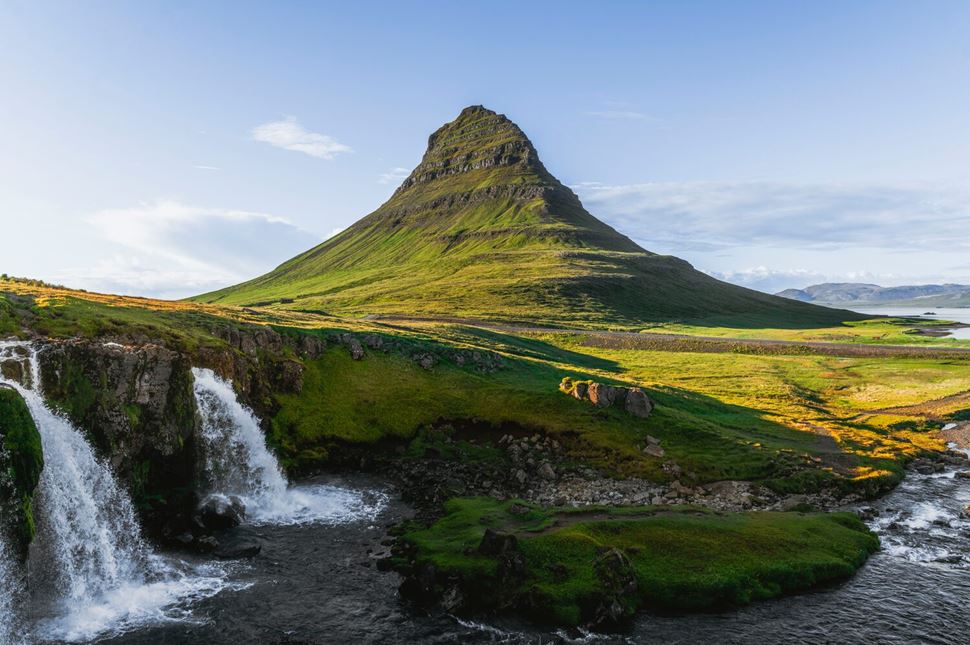
A steep trail winds up to the mountain peak, where hikers can witness an extraordinary view of the surrounding coastlines. To ascend the mountain takes about an hour and a half, with an additional one and a half hours to return to the bottom. Due to the elevation and trail conditions, you should only hike Kirkjufell with an expert guide. Kirkjufell small group tours are a best selling Iceland excursion.
Visitors who wish to admire the peak from a distance can enjoy the serene lake at the base. On clear days the giant pool reflects a mirror image of the mountain.
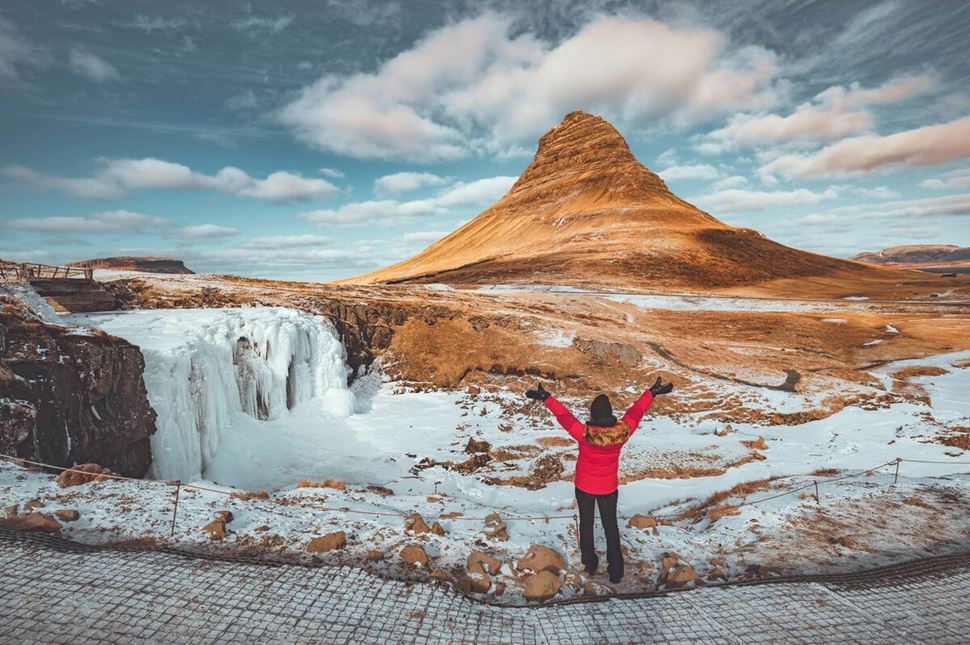
Just within walking distance of Kirkjufell is another photogenic natural feature. Kirkjufellsfoss, or ‘Church Mountain Falls,’ is a lovely three-tiered waterfall. Smaller than some of Iceland’s other waterfalls, the mountain backdrop creates a picturesque scene.
Fit for a postcard, the Kirkjufell and Kirkjufellsfoss vista changes with the season. During the summer visitors will witness vivid green fields, while in the winter the mountain transforms into white and brown. The best view, however, comes under the glow of the Northern Lights!

Hvítserkur, nicknamed the Troll of Northwest Iceland, is a 15 m (49 ft) tall basalt sea stack located in Húnaflói Bay. The distinct rock formation has three large holes, caused by erosion from the sea, to form what looks like a mythological creature.
The popular lore surrounding the rock is that it’s a troll petrified by the sun, while others believe it resembles a rhino or dragon. Nesting seabirds living on the rock give the whimsical illusion that the sea stack is in motion.
The eastern shore of the Vatnsnes Peninsula offers the best view of Hvítserkur and is the best seal-watching point in Iceland.
Nestled between the northwest towns of Hvammstangi and Blönduós is Kolugljúfur. The gorge is one of the lesser-known northwest Iceland attractions but is equally breathtaking as the others.

Within the 1 kilometer long and 60 meters (197 ft) wide canyon flows the powerful Víðidalsá River, known for its salmon. Kolufossar are the accompanying falls, which cascade peacefully into the rugged gorge
Both the gorge and waterfall are named after the giantess, Kola, who legend says lived in the area. It is said she used to sit on a ledge at night and snatch the salmon traveling upstream.
Grettislaug is a famous geothermal pool in northwest Iceland, surrounded by folklore. The pool is said to be named for the main character of one of Iceland’s most famous Sagas, Grettis Saga, about an outlaw. Legend has it he bathed in the geothermal waters to prevent dying from the chill of the sea.

The pool is not the original, a storm destroyed the site in the early 20th Century. However, locals rebuilt the pool in 1992 due to historical significance. Located on the coast of Skagifjörður, the pool offers stunning views of the surrounding area, including Drangey Island.
To enjoy the relaxing site requires a small fee, as it’s located on private property. Changing facilities are available onsite.
Sea kayaking tours are a great way to see north west Iceland attractions. There is no better spot for this activity than the picturesque Breidafjordur Bay in Snaefellsnes Peninsula, with its numerous islands and diverse wildlife.
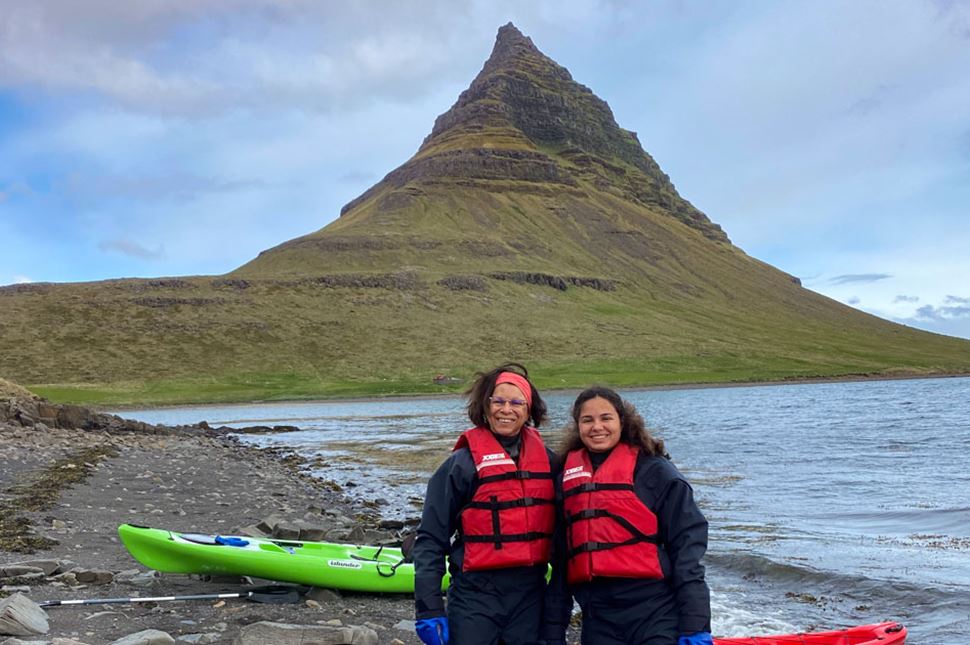
Excursions begin from Stykkisholmur, a charming village with a lovely coastline. The harbor has garnered some fame, after its feature in the film The Secret Life of Walter Mitty.
Paddling along the bay you’ll be met with views of remote islands, tall basalt columns, a lovely little lighthouse, and lush nature. Witness the wildlife of the bay as you are surrounded by seals, puffins, and occasionally even whales.
These small group tours are beginner-friendly and no prior kayaking experience is needed. Before setting off to sea your guide will give you all the necessary gear, instructions, and a safety briefing. Truly a once in a lifetime experience, explore a new side of Iceland!
Discover the canyons and rivers of Iceland on the most unforgettable river rafting excursions! Home to countless roaring rivers, it’s easy to see why the country ranks among the top rafting spots in Europe. Tours are offered for every skill level, so there is something for everyone.

For beginners and families looking for a fun, easy adventure, the Wonderful West Family Rafting Tour is a gentler whitewater experience. An expert guide will lead you through the Vestari Jokulsa, ‘The West Glacial River,’ located in Skagafjordur.
A relatively level area, glide through the Throngagil canyon while taking in the surrounding wilderness. West river rides begin from the Hafgrímsstaðir Rafting Base.
Looking for more of an adrenaline rush — simply look east. Austari-Jokulsa, known as ‘The Beast of the East’, is a glacial river to the east of Skagafjordur. Beginning at Hofsjökull Glacier, it is a collection of streams and rivers that flow down the Austurdalur Valley.
The powerful Austari-Jokulsa has been called one of the best white water rafting rivers in Europe. Due to its powerful rapids, this grade 4+ rafting tour is only open to strong swimmers. Previous rafting experience is needed.
If you are looking for a heart-pumping adventure, the Beast of the East River Rafting Tour should be at the top of your list!
Snæfellsjökull is a glacier-capped volcano housed inside Snæfellsnes National Park. The ancient stratovolcano beneath the glacier dates back 700,000 years and has been the subject of mysticism and lore for centuries.

Legends surrounding Snæfellsjökull might be the reason Jules Verne used the site as the backdrop for his famous book “Journey to the Center of the Earth.”
Snæfellsjökull Glacier hike tours are a popular way to explore this iconic glacier. Summits up this glacial volcano will take you across the diverse terrain that you can only find in the Land of Fire and Ice! The first part of your journey takes you across volcanic and lava rocks, then transforms to glacier and ice as we near the top.
At the top of this 1,446 meters (4,744 feet) tall mountain, you will be rewarded with a marvelous view of the Snaefellsnes Peninsula and Westfjords.
The Northern Lights are the most popular and fickle natural attraction in Iceland. People travel from around the globe in hopes of catching this supernatural looking spectacle.
While Northern Lights sightings often come down to luck, the remote northwest is one of the best spots in the country for aurora hunting. Far away from the city light pollution, multi-day tours in the region include Northern Lights searches in their itinerary.

Discover the attractions of the Snaefellsnes Peninsula by day, and chase the mystical aurora by night. The Snaefellsnes Peninsula was picked as the best winter destination in Europe, the only season the Northern Lights are visible.
While there are no sighting guarantees, the Northern Lights & Snaefellsnes Peninsula Tour won’t leave you without memorable moments. Discover the beautiful Icelandic nature of this region!
Self-drive tours are a great way to explore Iceland at your own pace. The Ring Road (Route 1) is the most popular route and takes drivers on a complete loop around the country. While Route 1 offers easy access to attractions in South Iceland, the East Fjords, North Iceland and Snaefellsnes Peninsula, sights like the remote Westfjords are harder to get to.
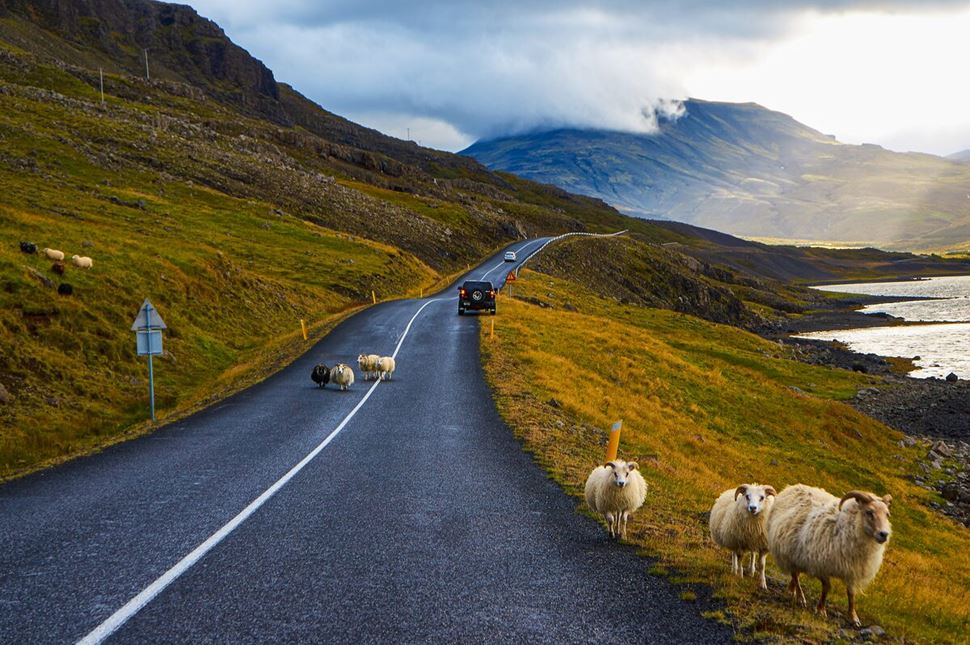
Roads in the Westfjords have become notorious for their rough conditions. This reputation is changing, however, as the entire road #61 is now paved, as well as the majority of road #60. To reach the Northwest attractions of Látrabjarg and Rauðasandur requires a drive over some gravel roads. During the summer these roads are open to all types of cars, however, road conditions change quickly.
During the winter navigating even the main roads can be tricky. If you plan on driving during the winter we advise traveling in a 4-wheel drive with winter tires. Please note that the mountain roads of Hrafnseyrarheiði and Dynjandisheiði (on road #60) are closed during most of the winter.
Self-drive tours in this region can be tricky so traveling with one other person or group is recommended. Make sure to always check the latest road condition information from the Iceland Road Administration before you hit the road. For uneasy drivers multi-day tours offer tours around the Ring Road, so you can have a fun, safe adventure with an expert driving guide.
People who want to explore the stunning wilderness of this region have a variety of accommodations to choose from. North west hotels in Iceland can be found in the charming villages and towns, or for the more rugged explorer, there are multiple campsites.
Choose from cottages, guesthouses, and farmhouses, some complete with WiFi, breakfast, and free parking. For easier overnight options multi-day tour packages include accommodations in the price.

Adventure Hotel Hellissandur
Located in the 'miniature Iceland' of the Snæfellsnes Peninsula, Adventure Hotel Hellissandur offers cozy and budget-friendly accommodations. With 20 rooms suited for individuals, couples, and families, each room comes with private bathrooms, ensuring a comfortable stay. The hotel is a perfect base for exploring nearby attractions like the Maritime Museum and the National Park Center in Hellissandur. Guests can start their day with a delicious breakfast in the spacious restaurant before heading out to explore.
The hotel's proximity to natural wonders like Snæfellsjökull National Park, Skarðsvík beach, and Svortuloft lighthouse, as well as the Vatnshellir cave, makes it an ideal location for those looking to immerse themselves in Iceland's breathtaking landscapes. Book your stay here!
Camping is a fun way to experience Icelandic nature firsthand, however, it requires careful pre-planning. In Iceland, it is illegal to sleep in trailers, campers, caravans, or camper vans outside of organized campsites. Campers may pitch tents in uninhabited areas if there are no restrictions or prohibited access indicated.
There are a number of official campgrounds in the northwest region, close to the area’s popular sightseeing attractions.
Patreksfjörður Camping Ground is located in the town of Patreksfjörður, which has a variety of restaurants, cafes, stores, and a swimming pool. The grounds are close to the Rauðisandur Beach, Látrabjarg Cliffs, and Dynjandi Waterfall.
A more traditional campground, Þingeyri offers a variety of amenities including electricity, lavatory disposal for motorhomes, a washing machine and dryer, as well as a wheelchair-accessible service building. There is a beach volleyball court and play area.
Other camping grounds with full-service facilities are Tungudalur Camping Ground and Bolungarvik Camp Site. Hotel Heydalur is a hotel that also operates as a campsite with an onsite restaurant.
Out in the more remote areas, such as the wild Westfjords, it is important to make sure you have all the necessary equipment, food, and clothing as there are no service stations or villages nearby.
Inexperienced travelers are encouraged to explore this area with tour groups and take advantage of pre-arranged accommodations.
Northwest Iceland has both large cities and small towns. Visitors can check out historical sights, heritage museums, and wilderness exhibits located in these settlements.
The biggest Northwest town is Sauðárkrókur, with a population of 3000. A flourishing agricultural area and fishing operator, the town is the busiest community outside of Reykjavik. Here visitors can find a variety of services such as: museums, exhibitions, shops, restaurants, accommodations, a swimming pool, and a hospital.
Ísafjörður is the largest city in Westfjords with a population of about 2,600. Despite its size, it’s fairly metropolitan with a cultural center, library, school of music, hospital and even its own airport. The city has made a name for itself in the music scene, hosting the popular Aldrei fór ég suður and Við Djúpið music festivals.
There is no shortage of charming towns to explore, and Hvammstangi, Skagi and Tröllaskagi are among the most popular. Check out the historic Hofsós, one of the oldest trading ports in northern Iceland, established back in the 16th century. Hofsós has developed into a tourist attraction over the years and has the Icelandic Emigration Center.
Yes. Our bestselling Snaefellsnes & Kirkjufell Small Group Tour departs from Reykjavik, offering you the chance to explore the highlights of the peninsula.
Additionally, all of our multi-day tours include pick-up and drop-off from Reykjavik. Explore the Snæfellsnes Peninsula and nearby glacial landscapes then hunt for the aurora borealis on our Northern Lights on our 4-day Northern Lights, Snæfellsnes & Glacier Lagoon tour!
Just like in the rest of Iceland, the temperature in the Northwest varies greatly and can be very unpredictable. The warmest time of year in the Snaefellsnes Peninsula is late July where highs hit around 13.5°C (56.3°F) and temperatures rarely drop below 7.8°C (46.1°F) at night. During the winter the average high is between 4.7°C (40.4°F) and -0.3°C. (31.5°F).

Iceland’s weather is famously unpredictable, cycling through all four seasons in one day. The most important packing hack is layers, layers, and more layers! Items that will come in handy include:
Summer is the best time of year to visit Northwest Iceland. The vibrant wilderness is in full bloom and visitors can observe the abundance of wildlife, like the Atlantic Puffin who only nests during the summer. The sun barely sets in the region so you can enjoy sightseeing all day long.
Due to the sometimes harsh winter conditions in the northwest, some activities are limited, however, there is one that is only available during these months. Located right against the Arctic Circle, the Northwest is the perfect spot to hunt for the Northern Lights. Join our 2 Day Snaefellsnes Peninsula Tour to search for magical auroras!